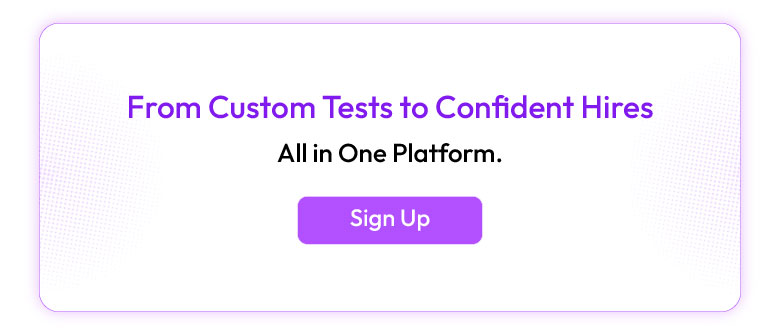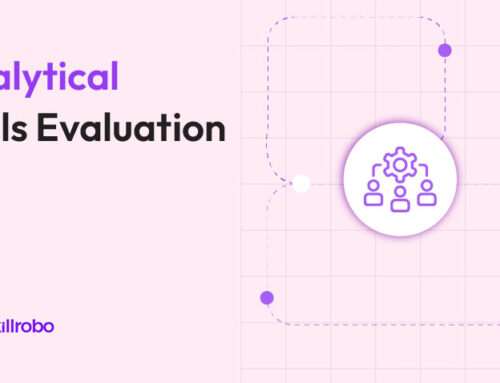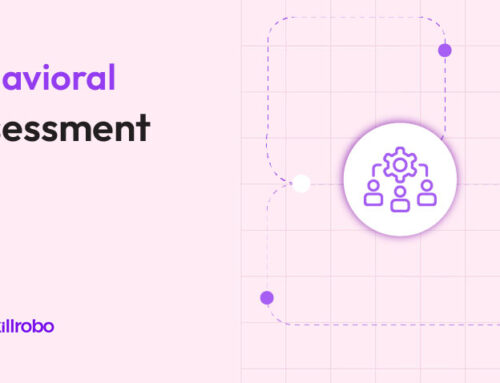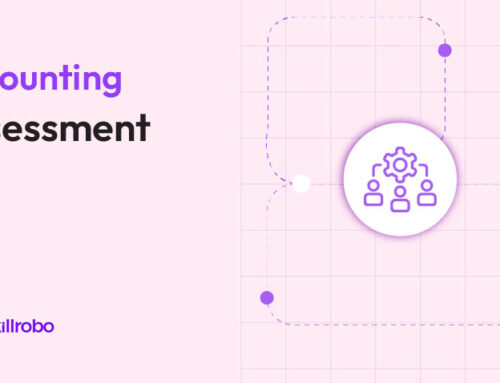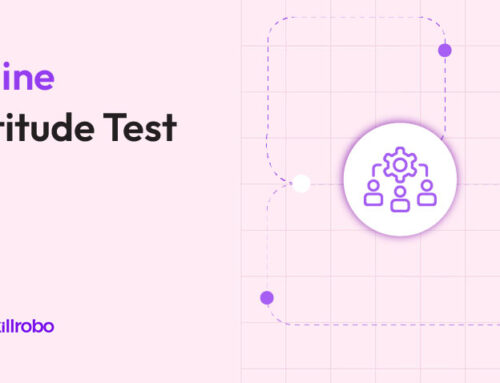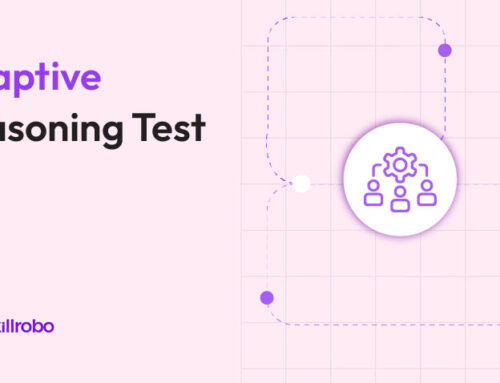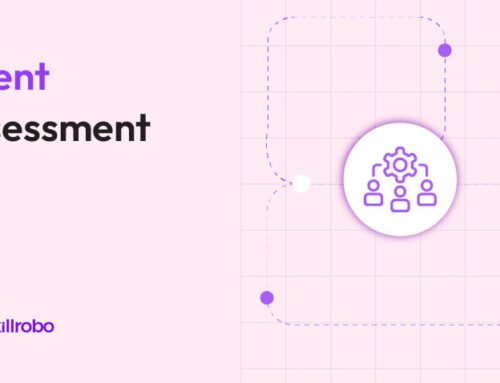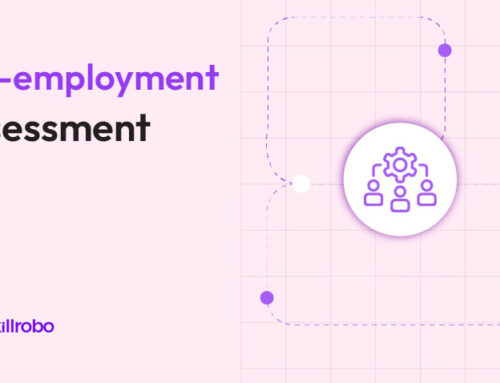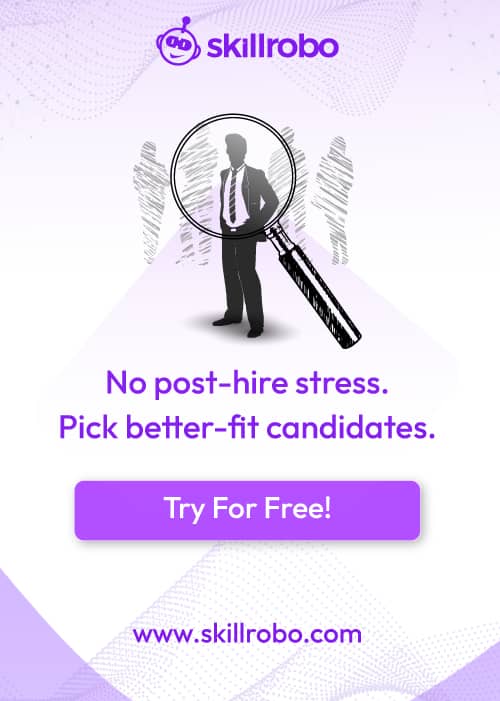Table of Contents
- Key Takeaways
- Why Behavioral Assessment Matters in Hiring
- What is a Behavioral Assessment?
- Benefits of Behavioral Assessment in Recruitment
- Different Types of Behavioral Assessments in the Employment Process
- Behavioral Assessment vs. Personality Assessment
- Key Traits Behavioral Assessments Evaluate
- Best Practices for Using Behavioral Assessments
- How Skillrobo Enhances Behavioral Assessment
- Final Words: Behavioral Insights Power Smarter Hiring
Related articles

Key Takeaways
- Behavioral assessments help predict a candidate’s workplace behavior, communication style, and cultural fit.
- Behavioral assessment tests complement technical evaluations by revealing soft skills essential for success.
- Personality and behavioral assessments provide insights into leadership potential, teamwork, and stress management.
- Skillrobo offers secure, customizable behavioral testing solutions to streamline better hiring and talent development.
Why Behavioral Assessment Matters in Hiring
Today’s hiring decisions can’t rely solely on resumes or hard skills. According to LinkedIn’s Global Talent Trends Report, 92% of HR professionals say soft skills are equally or more important than hard skills when hiring.
In this blog, we’ll explore how behavioral assessment tools help organizations evaluate candidates more holistically and make smarter hiring decisions.
Behavioral assessment helps hiring teams evaluate how a candidate will think, act, and interact in real-world work situations. They measure key traits like emotional intelligence, resilience, communication, collaboration, and leadership potential.
By using behavioral assessment tools, organizations gain deep insights that complement technical skills testing and ensure better role alignment, lower turnover, and stronger teams.
What is a Behavioral Assessment?
A behavioral assessment is a systematic method used to observe, describe, explain, and predict a candidate’s future behavior in a workplace environment. Unlike skills assessment tests, which measure task-specific abilities, behavioral assessments reveal how a person behaves under different conditions.
Behavioral evaluations can include:
- Self-assessment questionnaires
Candidates reflect on their own behavioral traits, work preferences, and soft skills through structured questionnaires. This helps reveal self-awareness, values, and preferred working styles that may not surface during traditional interviews.
- Situational judgment tests
Candidates are presented with hypothetical workplace scenarios and asked how they would respond. Their answers offer insights into problem-solving ability, decision-making style, emotional intelligence, and adaptability under pressure.
- Personality inventories
Standardized tests like the Big Five or DISC profile assess enduring personality traits, such as openness, conscientiousness, extraversion, agreeableness, and emotional stability. These inventories help predict how well a candidate will fit within your team and company culture.
- Group exercises
Observed group tasks simulate real-world collaboration challenges. These exercises reveal communication skills, teamwork, leadership potential, and conflict resolution abilities when candidates interact under time constraints.
- Behavioral interview questions
Instead of hypothetical questions, behavioral interviews ask candidates to describe past experiences (“Tell me about a time when…”). Their responses demonstrate how they approach challenges, resolve conflicts, prioritize tasks, and work with others based on actual behavior.
These tests help hiring managers understand both behavioral traits and underlying motivators critical to long-term success.
Benefits of Behavioral Assessment in Recruitment
Finding candidates with the right technical skills is only half the battle. Behavioral assessment ensures you also hire individuals who align with your company’s values, culture, and goals. Here’s why integrating behavioral evaluation into recruitment is essential today:
1. Better Cultural Fit
Cultural alignment is critical for team collaboration and retention. Behavioral assessments help you understand if a candidate’s values, communication style, and decision-making align with your company culture.
2. More Predictable Job Performance
Behavioral traits like resilience, adaptability, and collaboration are strong predictors of workplace success—often more than technical expertise.
3. Reduce Hiring Bias
Behavioral assessments provide structured, consistent data across candidates, reducing unconscious bias in interviews.
4. Strengthen Leadership Pipelines
Behavioral assessments can spot future leaders early by measuring traits like initiative, empathy, and problem-solving.
5. Enhance Team Dynamics
Building teams with complementary behavioral styles improves innovation, communication, and performance.
Different Types of Behavioral Assessments in the Employment Process
Here are the top five behavioral tests that are available for usage if you’re curious about your options. Learn what each of them tests and how they function.
1. DISC Test
The DISC test is a popular personality assessment tool used in the hiring process. It measures an individual’s behavioral style based on four personality traits: Dominance, Influence, Steadiness, and Conscientiousness. These four traits are represented in a quadrant chart that indicates an individual’s natural tendencies and preferences.
Here’s how the DISC test works in the hiring process, it functions by evaluating an individual in the following areas:
- Dominance (D): How tenacious or assured they are in their abilities
- Influence (I): Their capacity to forge deep professional connections and how influential or motivating they are to others.
- Steadiness (S): How steady, reliable, and constant they are.
- Compliance (C): Depending on their level of experience, how task-oriented, cautious, and exact they are.
The DISC test is useful in hiring because it provides insights into a candidate’s behavioral style, communication style, and work preferences. It can help employers identify potential strengths and weaknesses in candidates and match them to the job requirements and organizational culture. It can also be used to inform onboarding, training, and development plans for new hires. However, it’s important to note that the DISC test should be used in combination with other selection methods and should not be the sole determinant of hiring decisions.
2. Enneagram Test
The Enneagram Test is a personality assessment tool that identifies an individual’s dominant personality traits and how they relate to nine different personality types. It is based on the idea that people can be classified into nine distinct personality types, each with their strengths, weaknesses, and motivations.
In the context of the hiring process and workplace, this test can be used as a tool to help employers better understand their employees’ strengths, weaknesses, and motivations. This can help them make better hiring decisions, as well as provide more effective training and development opportunities for their employees.
During the employment process, employers can utilize the Enneagram Test to pinpoint applicants who possess the personality traits and qualifications necessary for the position. For instance, if a position calls for strong leadership abilities, a potential employer might search for people who fall into the Enneagram Type 8 (The Challenger) category. The Enneagram Test can be used in the workplace to help managers and team leaders better understand the personalities of their employees and how they can collaborate more successfully.
3. Big Five Test
The Big Five Test can be a useful tool in the hiring process, assisting businesses in locating applicants who are most likely to succeed in particular positions and suit the culture of the company. It should be applied fairly and impartially, nevertheless, and utilized when combined with other recruiting criteria. Employers can boost their chances of securing the top candidates for their positions by doing this.
The Five-Factor Model (FFM), often known as the OCEAN model or the Big Five Personality Test, is a popular tool in psychology that aims to define and quantify five main aspects of personality. These are the five dimensions:
- Openness to experience: This quality assesses a person’s originality, imagination, and level of curiosity as well as their desire to try new things.
- Conscientiousness: This factor assesses a person’s degree of organization, self-control, and accountability.
- Extraversion: Extraversion is a personality trait that assesses a person’s friendliness, assertiveness, and stimulation tolerance.
- Agreeability: This trait assesses a person’s capacity for cooperation, empathy, and care for others.
- Neuroticism: This trait assesses a person’s susceptibility to stress, anxiety, and emotional instability.
The Big Five Test is composed of a series of questions or statements that the subject is asked to rate on a scale of 1 to 5, with 1 denoting significant disagreement and 5 denoting strong agreement. The scores the person receives on each of the five dimensions are then determined using these responses.
4. 16 Types Test
Based on Carl Jung’s theory of psychological types, which divides people into 16 different personality types according to their cognitive processes and preferences, the 16 Types Test is a tool for assessing personality. The Myers-Briggs Type Indicator (MBTI), which bears the names of the test’s designers Katharine Briggs and Isabel Briggs Myers, is another name for the assessment.
In the hiring process, the 16 Types Test can be used to assess whether an individual’s personality type is a good fit for a particular job or company culture. For example, an individual with an ISTJ personality type might be well-suited for a job that requires attention to detail and adherence to rules and regulations.
In the workplace, the 16 Types Test can be used to help teams work more effectively together by identifying individual strengths and weaknesses and facilitating communication and collaboration. For example, a team with a mix of personality types might be better able to tackle a complex problem because each individual brings a unique perspective and skill set to the table.
5. Culture Add Test
This test evaluates how closely a person’s values match those of the employer. It enables you to determine whether they are likely to adopt or follow the basic values of your business. You can determine which employees will have a good influence on your company culture with this test.
The Culture Add test is designed to reflect the core values of your business. First, a survey about your company’s values enables you to rank a list of beliefs, actions, and behaviors according to how well they align with those values.
The candidate is then given a survey and asked to rate the importance of the same values and behaviors on their own.
Behavioral Assessment vs. Personality Assessment
While often used interchangeably, behavioral and personality assessments focus on different aspects:
| Feature | Behavioral Assessment | Personality Assessment |
|---|---|---|
| Focus | How people act and react | Who people are fundamentally |
| Measurement | Observable behavior in specific contexts | Stable traits like introversion or openness |
| Usage | Hiring, leadership development | Self-awareness, career coaching |
| Example | Situational Judgement Test (SJT) | Myers-Briggs Type Indicator (MBTI) |
Key Traits Behavioral Assessments Evaluate
Behavioral assessments focus on key competencies that predict long-term success in a role. The main traits evaluated include:
1. Communication Skills
Measures how clearly, empathetically, and assertively a candidate expresses ideas. Strong communication is critical for collaboration, leadership, and client interaction roles.
2. Team Collaboration
Assesses a candidate’s ability to work effectively with diverse teams. It looks for cooperation, openness to feedback, and the ability to build positive work relationships.
3. Problem-Solving Skills
Evaluates logical thinking, creativity, initiative, and the ability to approach challenges strategically. Strong problem-solvers adapt quickly and find solutions under pressure.
4. Leadership Potential
Identifies individuals who can motivate teams, make strategic decisions, and guide others toward achieving goals. This trait is vital for managerial and leadership-track roles.
5. Adaptability
Tests flexibility when dealing with change, uncertainty, or unexpected challenges. Adaptable employees thrive in dynamic business environments.
6. Emotional Intelligence
Measures of self-awareness, empathy, self-regulation, and social skills. High emotional intelligence improves collaboration, conflict management, and leadership effectiveness.
Behavioral assessments offer a multi-dimensional view of a candidate, providing insights that technical tests or interviews alone can miss.
Best Practices for Using Behavioral Assessments
Behavioral assessments are a powerful recruitment tool, but to maximize their effectiveness, companies should follow these best practices:
1. Integrate Early in the Hiring Funnel
Administer behavioral assessments before final interviews to create an unbiased shortlisting process. Early testing ensures that you focus interviews on top-fit candidates, saving time and minimizing unconscious bias.
2. Customize Based on Roles
Every role demands different behavioral traits. Customize your assessments:
-
For marketing roles, prioritize creativity and communication.
-
For operations, assess adaptability and problem-solving.
-
For customer-facing roles, focus on emotional intelligence and resilience.
3. Use Data, Not Gut Feel
Base hiring decisions on objective behavioral data rather than subjective impressions. Use assessment scores, benchmarks, and comparative data to ensure fairness and consistency.
4. Combine with Skill Assessments
Behavioral assessments are most effective when paired with skills evaluations. This combination provides a complete view of a candidate’s ability to perform tasks and fit into the team or company culture.
5. Provide Candidate Feedback
Offer brief, constructive feedback after the assessment, whether the candidate moves forward or not.
How Skillrobo Enhances Behavioral Assessment
On Skillrobo, Behavioral assessments offer a powerful lens into a candidate’s future performance, but to unlock their full potential, companies must implement them thoughtfully. Here’s how to maximize their impact throughout your hiring process:
1. Role-Specific Behavioral Tests
Don’t wait until the final interview stage to evaluate behavior. Integrating behavioral assessments early ensures that hiring teams focus their energy only on candidates who fit both the role and the company culture.
-
Early behavioral data reduces bias and subjective decision-making later on.
-
It helps filter candidates who might have strong resumes but poor team fit or low adaptability.
-
Candidates who match your company’s behavioral profile are more likely to succeed and stay longer.
Pro Tip: Use behavioral assessments immediately after resume screening to streamline shortlisting.
2. Customizable Templates
Not all roles require the same behavioral traits. For example:
-
Sales roles need resilience, persuasion, and empathy.
-
Creative roles demand curiosity, innovation, and openness to new ideas.
-
Operations or logistics roles require problem-solving, reliability, and adaptability.
Tailoring assessments to the competencies that matter most for each role ensures your evaluations are highly relevant. Generic assessments lead to generic results—customization delivers precision.
Pro Tip: Work closely with hiring managers to identify 3–5 key traits essential for success in each specific role.
3. Secure Test Environment
While human intuition is valuable, relying solely on gut feeling often introduces unconscious biases.
-
Behavioral assessment results offer objective, standardized data on candidates’ soft skills.
-
Structured scorecards and benchmarks can be used to compare candidates fairly.
-
Quantitative behavioral data ensures hiring decisions are consistent, repeatable, and defensible.
Pro Tip: Combine data points from behavioral tests with technical evaluations for a complete, holistic view of each candidate.
4. Instant Reports
Behavior alone isn’t enough. A candidate might be highly adaptable but lack technical proficiency—or vice versa.
Pairing behavioral assessments with technical skills tests ensures:
-
The candidate can do the job (skills).
-
The candidate will fit into the team and thrive (behavior).
Platforms like Skillrobo allow you to bundle technical and behavioral evaluations seamlessly, offering a one-stop view of a candidate’s total fit.
Pro Tip: Map skills and behavior scores together to prioritize well-rounded candidates.
5. Integrated Hard and Soft Skills Testing
Behavioral assessments can feel opaque to candidates if no feedback is given.
-
Sharing even brief, constructive feedback builds trust and transparency.
-
Candidates appreciate companies that take time to inform them, even if they are not selected.
-
Positive candidate experiences enhance your employer brand and increase the likelihood of referrals or future applications.
Pro Tip: Offer feedback based on strengths identified in the assessment and one area for growth. This keeps the feedback encouraging yet actionable.
Skillrobo empowers HR teams to hire smarter, reduce bias, and build high-performing teams confidently.
Final Words: Behavioral Insights Power Smarter Hiring
Behavioral assessments are no longer optional—they’re essential for building agile, resilient, and high-performing teams. By understanding not just what candidates know but how they behave, you can unlock stronger performance, better retention, and a thriving workplace culture.
Platforms like Skillrobo make it easy to integrate behavioral assessment tests into your recruitment strategy, helping you hire the right people with precision and confidence.
Start your free trial with Skillrobo today and redefine smarter hiring!

Key Takeaways
- Behavioral assessments help predict a candidate’s workplace behavior, communication style, and cultural fit.
- Behavioral assessment tests complement technical evaluations by revealing soft skills essential for success.
- Personality and behavioral assessments provide insights into leadership potential, teamwork, and stress management.
- Skillrobo offers secure, customizable behavioral testing solutions to streamline better hiring and talent development.
Why Behavioral Assessment Matters in Hiring
Today’s hiring decisions can’t rely solely on resumes or hard skills. According to LinkedIn’s Global Talent Trends Report, 92% of HR professionals say soft skills are equally or more important than hard skills when hiring.
In this blog, we’ll explore how behavioral assessment tools help organizations evaluate candidates more holistically and make smarter hiring decisions.
Behavioral assessment helps hiring teams evaluate how a candidate will think, act, and interact in real-world work situations. They measure key traits like emotional intelligence, resilience, communication, collaboration, and leadership potential.
By using behavioral assessment tools, organizations gain deep insights that complement technical skills testing and ensure better role alignment, lower turnover, and stronger teams.
What is a Behavioral Assessment?
A behavioral assessment is a systematic method used to observe, describe, explain, and predict a candidate’s future behavior in a workplace environment. Unlike skills assessment tests, which measure task-specific abilities, behavioral assessments reveal how a person behaves under different conditions.
Behavioral evaluations can include:
- Self-assessment questionnaires
Candidates reflect on their own behavioral traits, work preferences, and soft skills through structured questionnaires. This helps reveal self-awareness, values, and preferred working styles that may not surface during traditional interviews.
- Situational judgment tests
Candidates are presented with hypothetical workplace scenarios and asked how they would respond. Their answers offer insights into problem-solving ability, decision-making style, emotional intelligence, and adaptability under pressure.
- Personality inventories
Standardized tests like the Big Five or DISC profile assess enduring personality traits, such as openness, conscientiousness, extraversion, agreeableness, and emotional stability. These inventories help predict how well a candidate will fit within your team and company culture.
- Group exercises
Observed group tasks simulate real-world collaboration challenges. These exercises reveal communication skills, teamwork, leadership potential, and conflict resolution abilities when candidates interact under time constraints.
- Behavioral interview questions
Instead of hypothetical questions, behavioral interviews ask candidates to describe past experiences (“Tell me about a time when…”). Their responses demonstrate how they approach challenges, resolve conflicts, prioritize tasks, and work with others based on actual behavior.
These tests help hiring managers understand both behavioral traits and underlying motivators critical to long-term success.
Benefits of Behavioral Assessment in Recruitment
Finding candidates with the right technical skills is only half the battle. Behavioral assessment ensures you also hire individuals who align with your company’s values, culture, and goals. Here’s why integrating behavioral evaluation into recruitment is essential today:
1. Better Cultural Fit
Cultural alignment is critical for team collaboration and retention. Behavioral assessments help you understand if a candidate’s values, communication style, and decision-making align with your company culture.
2. More Predictable Job Performance
Behavioral traits like resilience, adaptability, and collaboration are strong predictors of workplace success—often more than technical expertise.
3. Reduce Hiring Bias
Behavioral assessments provide structured, consistent data across candidates, reducing unconscious bias in interviews.
4. Strengthen Leadership Pipelines
Behavioral assessments can spot future leaders early by measuring traits like initiative, empathy, and problem-solving.
5. Enhance Team Dynamics
Building teams with complementary behavioral styles improves innovation, communication, and performance.
Different Types of Behavioral Assessments in the Employment Process
Here are the top five behavioral tests that are available for usage if you’re curious about your options. Learn what each of them tests and how they function.
1. DISC Test
The DISC test is a popular personality assessment tool used in the hiring process. It measures an individual’s behavioral style based on four personality traits: Dominance, Influence, Steadiness, and Conscientiousness. These four traits are represented in a quadrant chart that indicates an individual’s natural tendencies and preferences.
Here’s how the DISC test works in the hiring process, it functions by evaluating an individual in the following areas:
- Dominance (D): How tenacious or assured they are in their abilities
- Influence (I): Their capacity to forge deep professional connections and how influential or motivating they are to others.
- Steadiness (S): How steady, reliable, and constant they are.
- Compliance (C): Depending on their level of experience, how task-oriented, cautious, and exact they are.
The DISC test is useful in hiring because it provides insights into a candidate’s behavioral style, communication style, and work preferences. It can help employers identify potential strengths and weaknesses in candidates and match them to the job requirements and organizational culture. It can also be used to inform onboarding, training, and development plans for new hires. However, it’s important to note that the DISC test should be used in combination with other selection methods and should not be the sole determinant of hiring decisions.
2. Enneagram Test
The Enneagram Test is a personality assessment tool that identifies an individual’s dominant personality traits and how they relate to nine different personality types. It is based on the idea that people can be classified into nine distinct personality types, each with their strengths, weaknesses, and motivations.
In the context of the hiring process and workplace, this test can be used as a tool to help employers better understand their employees’ strengths, weaknesses, and motivations. This can help them make better hiring decisions, as well as provide more effective training and development opportunities for their employees.
During the employment process, employers can utilize the Enneagram Test to pinpoint applicants who possess the personality traits and qualifications necessary for the position. For instance, if a position calls for strong leadership abilities, a potential employer might search for people who fall into the Enneagram Type 8 (The Challenger) category. The Enneagram Test can be used in the workplace to help managers and team leaders better understand the personalities of their employees and how they can collaborate more successfully.
3. Big Five Test
The Big Five Test can be a useful tool in the hiring process, assisting businesses in locating applicants who are most likely to succeed in particular positions and suit the culture of the company. It should be applied fairly and impartially, nevertheless, and utilized when combined with other recruiting criteria. Employers can boost their chances of securing the top candidates for their positions by doing this.
The Five-Factor Model (FFM), often known as the OCEAN model or the Big Five Personality Test, is a popular tool in psychology that aims to define and quantify five main aspects of personality. These are the five dimensions:
- Openness to experience: This quality assesses a person’s originality, imagination, and level of curiosity as well as their desire to try new things.
- Conscientiousness: This factor assesses a person’s degree of organization, self-control, and accountability.
- Extraversion: Extraversion is a personality trait that assesses a person’s friendliness, assertiveness, and stimulation tolerance.
- Agreeability: This trait assesses a person’s capacity for cooperation, empathy, and care for others.
- Neuroticism: This trait assesses a person’s susceptibility to stress, anxiety, and emotional instability.
The Big Five Test is composed of a series of questions or statements that the subject is asked to rate on a scale of 1 to 5, with 1 denoting significant disagreement and 5 denoting strong agreement. The scores the person receives on each of the five dimensions are then determined using these responses.
4. 16 Types Test
Based on Carl Jung’s theory of psychological types, which divides people into 16 different personality types according to their cognitive processes and preferences, the 16 Types Test is a tool for assessing personality. The Myers-Briggs Type Indicator (MBTI), which bears the names of the test’s designers Katharine Briggs and Isabel Briggs Myers, is another name for the assessment.
In the hiring process, the 16 Types Test can be used to assess whether an individual’s personality type is a good fit for a particular job or company culture. For example, an individual with an ISTJ personality type might be well-suited for a job that requires attention to detail and adherence to rules and regulations.
In the workplace, the 16 Types Test can be used to help teams work more effectively together by identifying individual strengths and weaknesses and facilitating communication and collaboration. For example, a team with a mix of personality types might be better able to tackle a complex problem because each individual brings a unique perspective and skill set to the table.
5. Culture Add Test
This test evaluates how closely a person’s values match those of the employer. It enables you to determine whether they are likely to adopt or follow the basic values of your business. You can determine which employees will have a good influence on your company culture with this test.
The Culture Add test is designed to reflect the core values of your business. First, a survey about your company’s values enables you to rank a list of beliefs, actions, and behaviors according to how well they align with those values.
The candidate is then given a survey and asked to rate the importance of the same values and behaviors on their own.
Behavioral Assessment vs. Personality Assessment
While often used interchangeably, behavioral and personality assessments focus on different aspects:
| Feature | Behavioral Assessment | Personality Assessment |
|---|---|---|
| Focus | How people act and react | Who people are fundamentally |
| Measurement | Observable behavior in specific contexts | Stable traits like introversion or openness |
| Usage | Hiring, leadership development | Self-awareness, career coaching |
| Example | Situational Judgement Test (SJT) | Myers-Briggs Type Indicator (MBTI) |
Key Traits Behavioral Assessments Evaluate
Behavioral assessments focus on key competencies that predict long-term success in a role. The main traits evaluated include:
1. Communication Skills
Measures how clearly, empathetically, and assertively a candidate expresses ideas. Strong communication is critical for collaboration, leadership, and client interaction roles.
2. Team Collaboration
Assesses a candidate’s ability to work effectively with diverse teams. It looks for cooperation, openness to feedback, and the ability to build positive work relationships.
3. Problem-Solving Skills
Evaluates logical thinking, creativity, initiative, and the ability to approach challenges strategically. Strong problem-solvers adapt quickly and find solutions under pressure.
4. Leadership Potential
Identifies individuals who can motivate teams, make strategic decisions, and guide others toward achieving goals. This trait is vital for managerial and leadership-track roles.
5. Adaptability
Tests flexibility when dealing with change, uncertainty, or unexpected challenges. Adaptable employees thrive in dynamic business environments.
6. Emotional Intelligence
Measures of self-awareness, empathy, self-regulation, and social skills. High emotional intelligence improves collaboration, conflict management, and leadership effectiveness.
Behavioral assessments offer a multi-dimensional view of a candidate, providing insights that technical tests or interviews alone can miss.
Best Practices for Using Behavioral Assessments
Behavioral assessments are a powerful recruitment tool, but to maximize their effectiveness, companies should follow these best practices:
1. Integrate Early in the Hiring Funnel
Administer behavioral assessments before final interviews to create an unbiased shortlisting process. Early testing ensures that you focus interviews on top-fit candidates, saving time and minimizing unconscious bias.
2. Customize Based on Roles
Every role demands different behavioral traits. Customize your assessments:
-
For marketing roles, prioritize creativity and communication.
-
For operations, assess adaptability and problem-solving.
-
For customer-facing roles, focus on emotional intelligence and resilience.
3. Use Data, Not Gut Feel
Base hiring decisions on objective behavioral data rather than subjective impressions. Use assessment scores, benchmarks, and comparative data to ensure fairness and consistency.
4. Combine with Skill Assessments
Behavioral assessments are most effective when paired with skills evaluations. This combination provides a complete view of a candidate’s ability to perform tasks and fit into the team or company culture.
5. Provide Candidate Feedback
Offer brief, constructive feedback after the assessment, whether the candidate moves forward or not.
How Skillrobo Enhances Behavioral Assessment
On Skillrobo, Behavioral assessments offer a powerful lens into a candidate’s future performance, but to unlock their full potential, companies must implement them thoughtfully. Here’s how to maximize their impact throughout your hiring process:
1. Role-Specific Behavioral Tests
Don’t wait until the final interview stage to evaluate behavior. Integrating behavioral assessments early ensures that hiring teams focus their energy only on candidates who fit both the role and the company culture.
-
Early behavioral data reduces bias and subjective decision-making later on.
-
It helps filter candidates who might have strong resumes but poor team fit or low adaptability.
-
Candidates who match your company’s behavioral profile are more likely to succeed and stay longer.
Pro Tip: Use behavioral assessments immediately after resume screening to streamline shortlisting.
2. Customizable Templates
Not all roles require the same behavioral traits. For example:
-
Sales roles need resilience, persuasion, and empathy.
-
Creative roles demand curiosity, innovation, and openness to new ideas.
-
Operations or logistics roles require problem-solving, reliability, and adaptability.
Tailoring assessments to the competencies that matter most for each role ensures your evaluations are highly relevant. Generic assessments lead to generic results—customization delivers precision.
Pro Tip: Work closely with hiring managers to identify 3–5 key traits essential for success in each specific role.
3. Secure Test Environment
While human intuition is valuable, relying solely on gut feeling often introduces unconscious biases.
-
Behavioral assessment results offer objective, standardized data on candidates’ soft skills.
-
Structured scorecards and benchmarks can be used to compare candidates fairly.
-
Quantitative behavioral data ensures hiring decisions are consistent, repeatable, and defensible.
Pro Tip: Combine data points from behavioral tests with technical evaluations for a complete, holistic view of each candidate.
4. Instant Reports
Behavior alone isn’t enough. A candidate might be highly adaptable but lack technical proficiency—or vice versa.
Pairing behavioral assessments with technical skills tests ensures:
-
The candidate can do the job (skills).
-
The candidate will fit into the team and thrive (behavior).
Platforms like Skillrobo allow you to bundle technical and behavioral evaluations seamlessly, offering a one-stop view of a candidate’s total fit.
Pro Tip: Map skills and behavior scores together to prioritize well-rounded candidates.
5. Integrated Hard and Soft Skills Testing
Behavioral assessments can feel opaque to candidates if no feedback is given.
-
Sharing even brief, constructive feedback builds trust and transparency.
-
Candidates appreciate companies that take time to inform them, even if they are not selected.
-
Positive candidate experiences enhance your employer brand and increase the likelihood of referrals or future applications.
Pro Tip: Offer feedback based on strengths identified in the assessment and one area for growth. This keeps the feedback encouraging yet actionable.
Skillrobo empowers HR teams to hire smarter, reduce bias, and build high-performing teams confidently.
Final Words: Behavioral Insights Power Smarter Hiring
Behavioral assessments are no longer optional—they’re essential for building agile, resilient, and high-performing teams. By understanding not just what candidates know but how they behave, you can unlock stronger performance, better retention, and a thriving workplace culture.
Platforms like Skillrobo make it easy to integrate behavioral assessment tests into your recruitment strategy, helping you hire the right people with precision and confidence.
Start your free trial with Skillrobo today and redefine smarter hiring!


